The HTC 10 Review
by Joshua Ho on September 19, 2016 8:00 AM ESTBattery Life
Battery life is still one of the most important aspects of any mobile device, and as a result our testing of a mobile device needs to properly emphasize this aspect. As a result, it’s important that every device is tested in the same manner to avoid bias in one way or another. In order to achieve this, all devices have all possible background services disabled, as well as sync and automatic app updates. In order to try and make an even comparison we also set the display to 200 nits brightness on a 100% average picture level display, also known as a blank white screen. However, one area that we aren’t necessarily able to control for 100% of the time is ambient temperature, device orientation, or material contact. While tests that don’t reach TDP limits won’t see any effects, TDP-limited tests will see a delta here, but it’s hard to estimate just how much of an impact exists here. While we might be able to do some power characterization, in most cases review units are not allowed to be torn down and with a general decrease in the number of devices with removable batteries power characterization has to be done through the fuel gauge which is often unreliable. With the HTC 10, this fuel gauge is only updated every minute so there’s realistically no way to actually test power outside of full rundown tests.

In our first test we can see that the Galaxy S7 is actually slightly down on power efficiency relative to the HTC 10. I went back and ran the HTC 10 on our basically display-bound battery life test and the Galaxy S7 gets around 12.34 hours while the HTC 10 gets 11.63 hours. That’s about a 5-6% delta which is almost entirely down to display efficiency, so I suspect that the difference here is actually due to optimizations in DVFS and other optimizations that would probably fall under the “PowerBiotics” branding that HTC seems to be using here.
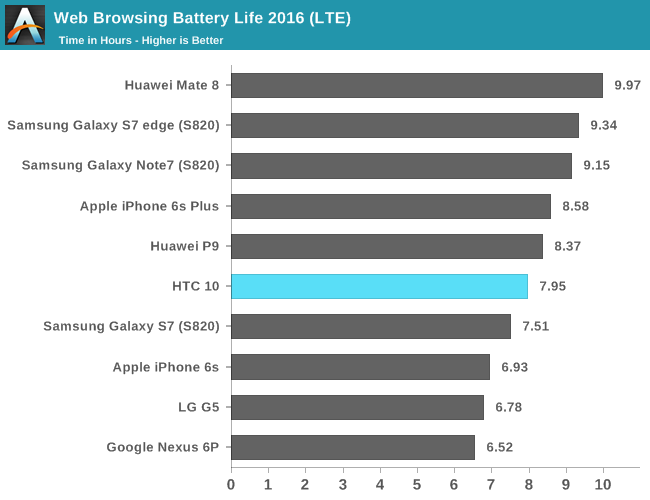
Moving on to the LTE version of this test we can see that HTC has really done an amazing job of implementing their cellular solution as battery life is basically identical to what it is on WiFi. It’s likely that poor reception conditions will tilt the scales back towards WiFi but in areas of good reception the HTC 10 has relatively good battery life on LTE. This is probably compounded by the fact that the HTC 10’s LTE reception is actually significantly above anything else I’ve used in recent memory including the LG G5 and Galaxy S7.
In the interest of trying to see whether this sort of pattern holds across the board, PCMark is another test that emphasizes power consumption but rather than just web browsing it attempts to have a mix of CPU and GPU usage in general purpose tasks as well as some general purpose IP blocks like video decode. While a relatively small part of overall power consumption, storage power consumption is also a part of the test as things like the photo editing subtest will involve reading and writing to non-volatile storage.
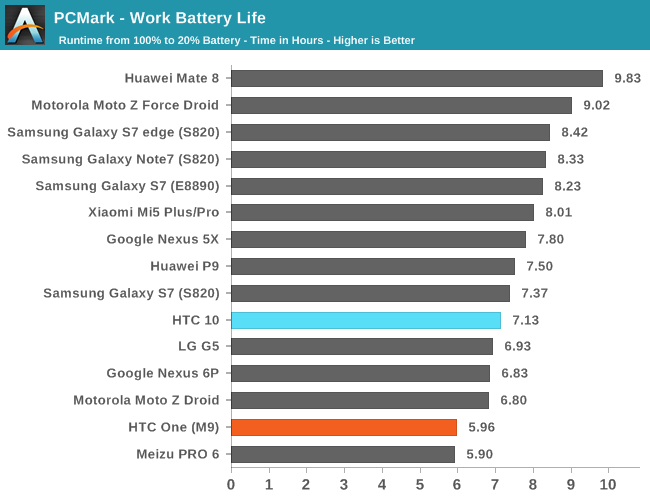
Interestingly enough, the HTC 10 ends up being slightly behind the Galaxy S7 here. Again, it’s likely that we’re looking at the difference in display power here as the Galaxy S7’s 1440p AMOLED display has a lower subpixel density and in a few tests the average picture level is relatively low. HTC is also using an ever so slightly larger display which would tilt the scales as well. Of course, none of this really changes the fact that display-bound workloads are going to see the HTC 10 performing worse than the Galaxy S7, but from an academic perspective it’s interesting to keep tabs on how AMOLED and LCD compare in terms of efficiency. It goes without saying that the Galaxy S7 edge with its huge battery easily pulls away from the HTC 10 and pretty much anything on the market but if you want a phone usable with one hand I would argue that the Galaxy S7 edge isn’t really a one-handed phone.
Moving on to the sustained rundown tests we can take a look at how an OEM has chosen to optimize their thermal management strategies, which often vary from device to device despite similar SoC and design. While we used to run Basemark OS II and GFXBench for this part of the test due to the arguably misleading results that Basemark OS II provides we’ve dropped it entirely to improve the signal to noise ratio of our reviews.
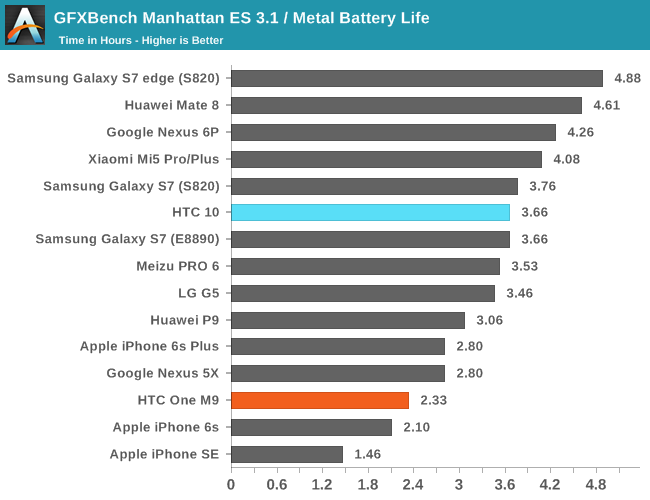
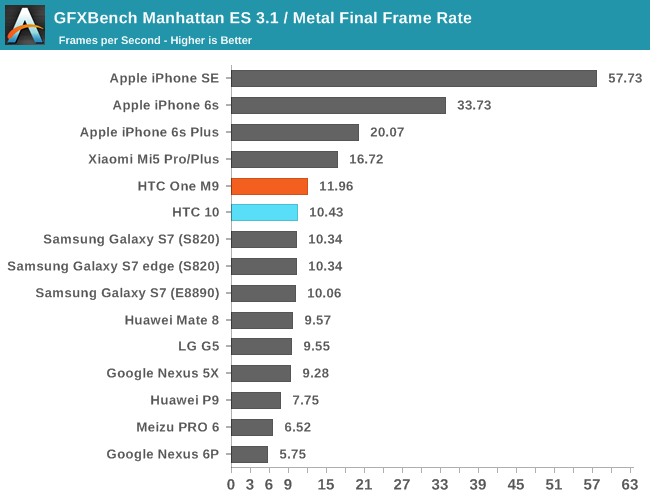
In GFXBench’s Manhattan ES 3.1 infinite rundown again we’re seeing the differences that come from display efficiency deltas but the difference is so small because SoC is pretty much the dominating factor when a display of this size will consume about a watt and the TDP-limited power consumption of the SoC is about two watts. What is noteworthy here is that HTC tends to do a better job of throttling the SoC such that the degradation is graceful. Samsung and LG both seem to favor maximizing short term performance which results in underdamped behavior which actually has a pretty appreciable impact on things like VR performance although given that no OEM is shipping Daydream-ready devices yet it isn’t necessarily critical for an OEM to be getting throttling right.
Overall, HTC does manages to pull in fairly respectable battery life despite being down on display efficiency. Our new tests manage to highlight the surprising level of optimization that HTC has put into the 10, but in use cases where you can’t really optimize things like cellular connectivity or governor behavior the HTC 10 slightly trails the Galaxy S7. When compared against something like the Galaxy S7 Exynos 8890 variants the HTC 10 is going to trail in anything CPU-bound as Kryo is just not as efficient as Exynos M1 for whatever reason. I don’t really think it’s a fair comparison but the Galaxy S7 edge is undoubtedly a big step up in battery life relative to the HTC 10, but this comparison only makes sense if you are willing to deal with the larger 5.5 inch display.
While I hate using screen-on time as a metric for battery life, generally speaking where the One M7 got about 3-4 hours of constant use when new the HTC 10 seems to achieve about 6 hours of use or so which is much more than what the 30% bump in battery capacity would suggest, especially once you factor in the half inch difference in display size, so the efficiency benefits of newer SoCs like the Snapdragon 820 are absolutely noticeable.
Charge Time
While battery life is probably the single most important metric of a mobile device, it’s important to not forget that these devices still need to spend at least some time wired up, whether directly in the form of an AC adapter or indirectly by swapping batteries. As a result it’s important to see how quickly the device’s battery will charge as generally speaking end users don’t hotswap batteries and charging the phone’s battery with an AC adapter is the dominant use case where charge time matters. To test this we use a number of methods, but for this review we will rely on measurements from the wall and using the time it takes for the device to drop to a certain level of power draw from the wall to indicate a full charge state, which is generally quite close to the time it takes for the device itself to indicate 100% but may take longer depending upon how an OEM adjusts battery state of charge determination and presentation.

It turns out that the HTC 10 charges fairly quickly, but it’s not necessarily as fast as what something with QC 2.0. This might seem counter-intuitive but realistically it’s not supposed to be faster than QC 2.0, but to reduce battery and device heating to better preserve the battery over time. Regardless, pretty much anything that charges in under 2 hours is going to be fairly comparable here. The Galaxy S7 does charge faster, but at the cost of overall battery lifetime. The LG G5 is actually slightly slower to charge here, so all things considered the HTC 10 is doing pretty well here. The one notable winner here is the OnePlus 3, which seems to charge quickly with relatively low battery heat due to its proprietary Dash Charge system.


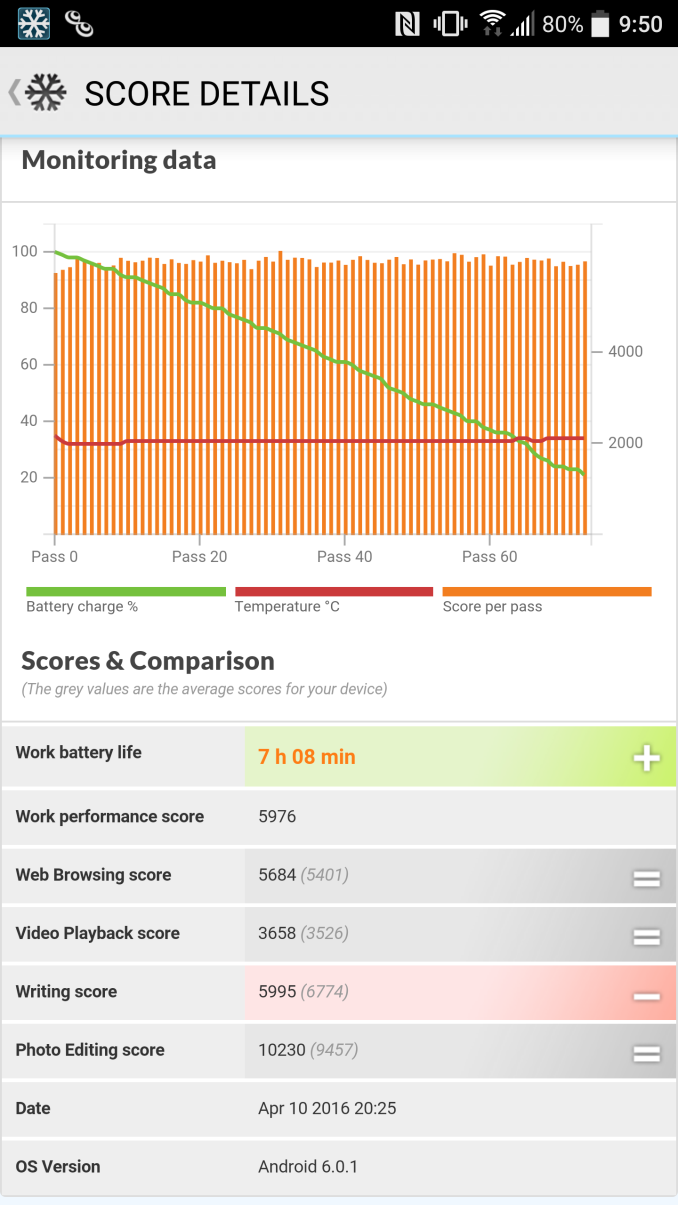
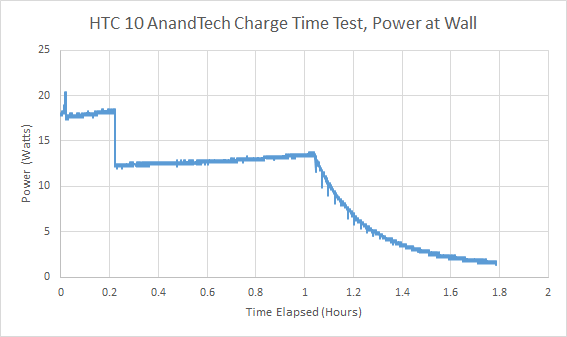








183 Comments
View All Comments
asfletch - Thursday, September 22, 2016 - link
Preach! Removable battery is big reason why I narrowed my choices recently to Note 4 or LG G5/V10, and only the fear of bootlooping (again a longevity issue, seems to happen to many people after several months of ownershup) put me off the LGs. I will only buy sealed-battery phones in future if I absolutely have to, and I would love to know how hard it'd be to change their batteries.Impulses - Thursday, September 22, 2016 - link
1. Agreed... But I can easily imagine logistical reasons why AT isn't allowed to open (and potentially destroy) review samples or personally bought devices, so we'll probably have to find this info elsewhere. I'm glad my N5 was easy to open even tho I never thought I'd keep it for 3 years.2. This is subjective, how hard is it to occasionally do some cleanup? Yeah, I know people actually toss phones over things as simple as full storage but c'mon, this is AT. I can see how a couple of comments about SD removal would be useful, tho I rarely took mine out when I had phones with them (specially after USB OTG and faster Wi-Fi came of age), phone has never been my primary camera either tho.
3. This is actually way too much of a moving target, and Samsung has actually been amongst the best at keeping non-carrier hobbled flagship models updated. HTC has probably been more consistent if you go farther back than the last 2-3 years tho... AT's forte has never been on the software side anyway.
4. Even more of a moving target with different carriers imposing different policies... And probably less relevant to the mass market. I don't think having a rooted Android device is nearly as attractive as it used to be, various drivers issue tend to make user/dev ROMs a dice roll when you're talking about unsupported Android versions.
If you care that much about that stuff you'll either research it at a place like Xda or you'll just get a Nexus, IMO. FWIW I think HTC still has far more user friendly policy regarding bootloader unlock than Samsung does.
AT phone reviews have always seemed to straddle an enthusiast/mass market line... They dive deep into hardware but only so much as in how it directly affects the user, and I don't think any big time site will ever cover things like how easy it is to repair, mod, etc. Just the nature of the beast, it's post because of the manufacturer relationships but also logistics. There's places like iFixit, XDA, and forums for that...
Zoomer - Thursday, September 22, 2016 - link
The SD tray is similar to the nanoSIM tray. Use a paperclip. It's more of a install once and forget kind of thing. Just pop in a 128 or 256 fast SD and forget about it. Far easier to transfer files by connecting a USB cable, which incidentally charges it.sevenmack - Friday, September 30, 2016 - link
Additionally, on the matter of two MicroSD ports: Most people barely use the one they have, often using a 32gb or 64gb card that is plenty for them. Enthusiasts such as myself would love two MicroSD ports, but I would also rather have a 500gb MicroSD card that would work for all my needs.As for teardowns to see how easy it is to replace a battery: Again, most people (including many enthusiasts) would never bother doing that. They would just buy another phone when the two-year update period comes up. Besides, iFixit provides ample enough information on that.
Fidelator - Monday, September 26, 2016 - link
You should be hired for this site, your thoughts are above and beyondVagabondjonez - Thursday, October 6, 2016 - link
I definitely agree with you 👍eclectech - Wednesday, September 21, 2016 - link
I've had my HTC 10 for months but I learned a lot reading this review. Thanks to your review, I also disabled Chrome and Google Photos, once I found the APKs for HTC Internet and HTC Gallery.Gunbuster - Wednesday, September 21, 2016 - link
Let me just type this out: Six.Hundred.DollarsJust got a BLU R1 HD today. $60, the end of ridiculous phone prices is nearing the end. It's not sustainable. I'm a techie and this phone is good enough. What makes a $600+ phone 10 times better?
ACM.1899 - Thursday, September 22, 2016 - link
Most buyers aren't techie....most of them are 15-30 years old that want to play HD games, watch FHD videos, listen to hq music...they want the best (based on Media or Gsmarena) and don't care that much about the money...they go to a store and all they can see is SAMSUNG and APPLE or let's say huawei...huawei used to be cheap, but now?...not much.
i think the only factor that would make a phone 10 times better (for "ordinary" buyers) is that it lasts 10 times(or whatever time that compensate the money).
look at HTC HD2 ,recently i saw one that could run Android 7...but NOT that good or smooth or enough ram left to run something else and it's a 7 years old phone. and we know that those who flash a custom rom or even root their phone is nothing compared to "ordinary" buyers.
btw in some countries you're stuck with whatever your carriers sell you.
ACM.1899 - Thursday, September 22, 2016 - link
And let's not forget about "Capitalism"